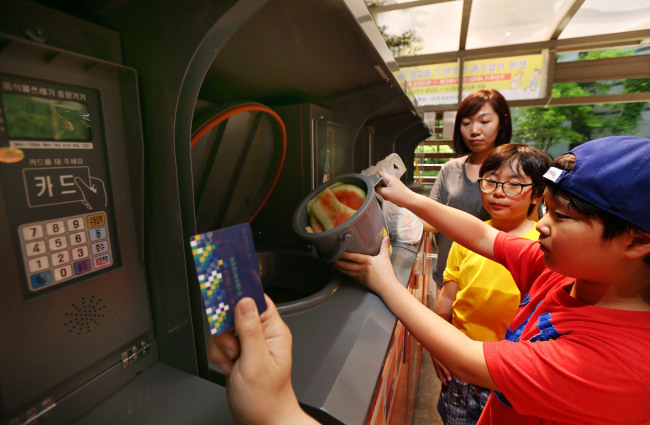
음식물쓰레기를 버린 만큼 부담금을 내는 음식 물쓰레기 종량제가 2일부터 전국적으로 시행됐다.
환경부에 따르면 현재 전국의 음식물쓰레기 분리배출 대상 144개 지자체 중 129 개 지자체가 종량제 시범사업을 하고 있으며 나머지 15개 지자체도 조례개정을 통해 연내 시행할 예정이다.
종량제 방식으로는 ‘납부칩·스티커제’, ‘RFID(무선주파수인식)시스템’, ‘전용 봉투제’ 등이 있다.
환경부는 음식물쓰레기 종량제가 본격 시행되면 쓰레기 배출량이 최대 20% 줄고 쓰레기 처리비용과 에너지 절약 등으로 5조원에 달하는 경제적 이익이 생길 것으로 분석한다.
그러나 각 지자체와 주택 유형별로 적용하는 종량제 방식이 다르고, 이에 따라 주민이 부담하는 수수료도 달라 상당한 혼선과 갈등이 우려된다.
아파트 등 공동주택에서는 세대별 종량제 방식인 RFID 시스템이나 단지별 종량 제 방식을, 단독주택에서는 납부칩·스티커제나 전용봉투제를 채택한다.
RFID 시스템을 채택한 공동주택에는 세대별 배출원 정보가 입력된 전자태그가 달린 수거함이 비치된다. 이곳에 음식물쓰레기를 버리면 자동으로 무게가 측정돼 고 지서 등을 통해 수수료가 각 가정에 부과된다.
단지별 종량제 방식을 택한 공동주택에서는 단지별 수거함에 버려진 음식물쓰레 기의 양을 측정, 합산한 뒤 수수료를 세대별로 균등하게 분배한다.
납부칩·스티커제는 편의점 등에서 구입한 납부칩이나 스티커를 부착한 수거용 기만 수거해 가는 방식이다.
전용봉투제는 배출자가 편의점 등에서 음식물쓰레기 전용봉투를 구입해 수수료 를 선납하는 방식으로 운영된다.
종량제 방식은 자치구의 재량과 재정여건 등에 따라 다르게 적용된다. 같은 자 치구 내에서도 아파트나 단독주택 등 주택 유형별로 종량제 방식이 다르다.
서울시를 보면 공동주택에서는 노원과 송파 등 19개 자치구가 비교적 예산이 적게 드는 단지별 종량제 방식을 적용한다.
금천·영등포·서초·종로·강서·강남 등 6개 구는 RFID 시스템인 세대별 종량 제 방식을 시행한다.
단지별 종량제 방식은 음식물쓰레기의 양을 합산한 뒤 수수료를 세대별로 동일하게 분배하기 때문에 1인 가구 등에 수수료가 과도하게 부과돼 갈등이 우려되고 감 량 효과도 떨어진다는 지적이 있다.
서울 송파구 아파트에 사는 김모(53·여)씨는 “우리집은 식구가 적어 음식물쓰 레기가 별로 나오지 않는데 단지별로 합산한 양에 따라 수수료를 균등하게 분배하는 것은 불합리하다”며 “각 세대 입장에서는 ‘버린만큼 내는 것’이 아니기 때문에 감량 효과가 있을지도 의문”이라고 지적했다.
<관련 영문 기사>
New food waste rules raise concerns
By Cho Chung-un
From this month on, what you don’t eat, you pay for.
Municipalities started to charge residents based on the volume or weight of their food trash as of Sunday as part of efforts to reduce processing costs and save energy.
Of 144 local district offices, 129 are the first to introduce various methods to charge for food waste.
They include having the residents pre-pay for their waste management by purchasing standard plastic bags, tags and stickers.
The pay-as-you-throw rule also includes a weight-based system under which residents are billed for the weight of their food waste. For this, a district office is required to install a computerized scale inside the public trashcan to weigh the waste. The equipment can also read radio-frequency identification tags that carry residents’ information to bill them.
The Environment Ministry hopes that the new rule will lower annual waste management costs by 20 percent, or 160 billion won. The amount of food waste will also be reduced by about 20 percent, it added.
The new rule, however, is likely to cause inconvenience and confusion to residents as they are bombarded with different disposal methods according to their house type or neighborhood. Apartment complexes are required to use either the weight-based system or a cost-sharing system, in which every household pays an equally divided service fee. Detached houses are recommended to purchase stickers or plastic bags.
Many complain that they were not given sufficient information on the new rules in advance and deprived of choice. Some methods such as the cost-sharing system are not perceived as fair because every household disposes a different amount of food but is charged the same amount. Concerns are also being raised over the additional maintenance costs imposed on municipalities if they install special devices for the weight-based system. There are also fears that some people may illegally throw food waste in with other residential waste to save money.
(christory@heraldcorp.com)








![[Graphic News] More Koreans say they plan long-distance trips this year](http://res.heraldm.com/phpwas/restmb_idxmake.php?idx=644&simg=/content/image/2024/04/17/20240417050828_0.gif&u=)
![[KH Explains] Hyundai's full hybrid edge to pay off amid slow transition to pure EVs](http://res.heraldm.com/phpwas/restmb_idxmake.php?idx=644&simg=/content/image/2024/04/18/20240418050645_0.jpg&u=20240419100350)





![[From the Scene] Monks, Buddhists hail return of remains of Buddhas](http://res.heraldm.com/phpwas/restmb_idxmake.php?idx=652&simg=/content/image/2024/04/19/20240419050617_0.jpg&u=20240419175937)

![[KH Explains] Hyundai's full hybrid edge to pay off amid slow transition to pure EVs](http://res.heraldm.com/phpwas/restmb_idxmake.php?idx=652&simg=/content/image/2024/04/18/20240418050645_0.jpg&u=20240419100350)

![[Today’s K-pop] Illit drops debut single remix](http://res.heraldm.com/phpwas/restmb_idxmake.php?idx=642&simg=/content/image/2024/04/19/20240419050612_0.jpg&u=)